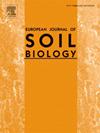Soil extracellular enzyme stoichiometry reveals the nutrient limitations of soil microbial metabolism under precipitation changes in Ningxia desert steppe of China
IF 3.3
2区 农林科学
Q1 ECOLOGY
引用次数: 0
Abstract
Soil microbial communities and extracellular enzyme activity in arid ecosystems are highly sensitive to precipitation changes, yet their metabolic responses remain poorly understood. Through a field precipitation experiment in the Ningxia's desert steppe, we found that increased precipitation significantly enhanced C-, N-, and P-acquiring enzyme activities, with extracellular enzyme stoichiometry revealing microbial P limitation. Soil microbial communities were dominated by the phyla Actinobacteriota, Chloroflexi, and Proteobacteria (bacteria) and Ascomycota (fungi) under altered precipitation. Structural equation modeling (SEM) revealed that biotic factors (community structure/diversity) exerted stronger control over metabolic limitations than abiotic factors, with P limitation surpassing C limitation. These findings highlight P availability as a critical constraint on microbial function in arid grasslands. Our study provides actionable insights for grassland restoration, suggesting targeted P fertilization could mitigate microbial nutrient limitations and enhance ecosystem resilience under climate change.
土壤胞外酶化学计量揭示了降水变化下宁夏荒漠草原土壤微生物代谢的养分限制
干旱生态系统中土壤微生物群落和胞外酶活性对降水变化高度敏感,但其代谢响应尚不清楚。通过宁夏荒漠草原的田间降水试验,我们发现,降水增加显著提高了C-、N-和P获取酶的活性,胞外酶化学计量揭示了微生物P的限制。降水变化条件下土壤微生物群落以放线菌门、绿菌门、变形菌门和子囊菌门为主。结构方程模型(SEM)显示生物因子(群落结构/多样性)对代谢限制的控制强于非生物因子,P限制大于C限制。这些发现强调了磷有效性是干旱草原微生物功能的关键制约因素。我们的研究为草地恢复提供了可操作的见解,表明有针对性的磷施肥可以缓解微生物营养限制,增强气候变化下的生态系统恢复能力。
本文章由计算机程序翻译,如有差异,请以英文原文为准。
求助全文
约1分钟内获得全文
求助全文
来源期刊

European Journal of Soil Biology
环境科学-生态学
CiteScore
6.90
自引率
0.00%
发文量
51
审稿时长
27 days
期刊介绍:
The European Journal of Soil Biology covers all aspects of soil biology which deal with microbial and faunal ecology and activity in soils, as well as natural ecosystems or biomes connected to ecological interests: biodiversity, biological conservation, adaptation, impact of global changes on soil biodiversity and ecosystem functioning and effects and fate of pollutants as influenced by soil organisms. Different levels in ecosystem structure are taken into account: individuals, populations, communities and ecosystems themselves. At each level, different disciplinary approaches are welcomed: molecular biology, genetics, ecophysiology, ecology, biogeography and landscape ecology.
 求助内容:
求助内容: 应助结果提醒方式:
应助结果提醒方式:


